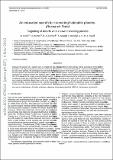| dc.contributor.author | Seager, Sara | |
| dc.contributor.author | Demory, Brice-Olivier | |
| dc.contributor.author | Bonfils, Xavier | |
| dc.contributor.author | Deming, Drake | |
| dc.contributor.author | Triaud, Amaury H.M.J. | |
| dc.contributor.author | Gillon, M. | |
| dc.date.accessioned | 2012-10-17T19:00:41Z | |
| dc.date.available | 2012-10-17T19:00:41Z | |
| dc.date.issued | 2010-11 | |
| dc.date.submitted | 2010-02 | |
| dc.identifier.issn | 0004-6361 | |
| dc.identifier.issn | 1432-0746 | |
| dc.identifier.uri | http://hdl.handle.net/1721.1/74054 | |
| dc.description.abstract | Because the planets of a system form in a flattened disk, they are expected to share similar orbital inclinations at the end of their formation. The high-precision photometric monitoring of stars known to host a transiting planet could thus reveal the transits of one or more other planets. We investigate here the potential of this approach for the M dwarf GJ 1214 that hosts a transiting super-Earth. For this system, we infer the transit probabilities as a function of orbital periods. Using Monte-Carlo simulations we address both the cases for fully coplanar and for non-coplanar orbits, with three different choices of inclinations distribution for the non-coplanar case. GJ 1214 reveals to be a very promising target for the considered approach. Because of its small size, a ground-based photometric monitoring of this star could detect the transit of a habitable planet as small as the Earth, while a space-based monitoring could detect any transiting habitable planet down to the size of Mars. The mass measurement of such a small planet would be out of reach for current facilities, but we emphasize that a planet mass would not be needed to confirm the planetary nature of the transiting object. Furthermore, the radius measurement combined with theoretical arguments would help us to constrain the structure of the planet. | en_US |
| dc.language.iso | en_US | |
| dc.publisher | EDP Sciences | en_US |
| dc.relation.isversionof | http://dx.doi.org/10.1051/0004-6361/201014239 | en_US |
| dc.rights | Creative Commons Attribution-Noncommercial-Share Alike 3.0 | en_US |
| dc.rights.uri | http://creativecommons.org/licenses/by-nc-sa/3.0/ | en_US |
| dc.source | arXiv | en_US |
| dc.title | An educated search for transiting habitable planets: (Research Note) Targetting M dwarfs with known transiting planets | en_US |
| dc.type | Article | en_US |
| dc.identifier.citation | Gillon, M. et al. “An Educated Search for Transiting Habitable Planets:” Astronomy & Astrophysics 525 (2010): A32. © ESO, 2010 | en_US |
| dc.contributor.department | Massachusetts Institute of Technology. Department of Earth, Atmospheric, and Planetary Sciences | en_US |
| dc.contributor.department | Massachusetts Institute of Technology. Department of Physics | en_US |
| dc.contributor.mitauthor | Seager, Sara | |
| dc.contributor.mitauthor | Demory, Brice-Olivier | |
| dc.relation.journal | Astronomy and Astrophysics | en_US |
| dc.eprint.version | Author's final manuscript | en_US |
| dc.type.uri | http://purl.org/eprint/type/JournalArticle | en_US |
| eprint.status | http://purl.org/eprint/status/PeerReviewed | en_US |
| dspace.orderedauthors | Gillon, M.; Bonfils, X.; Demory, B.-O.; Seager, S.; Deming, D.; Triaud, A. H. M. J. | en |
| dc.identifier.orcid | https://orcid.org/0000-0002-6892-6948 | |
| mit.license | OPEN_ACCESS_POLICY | en_US |
| mit.metadata.status | Complete | |
